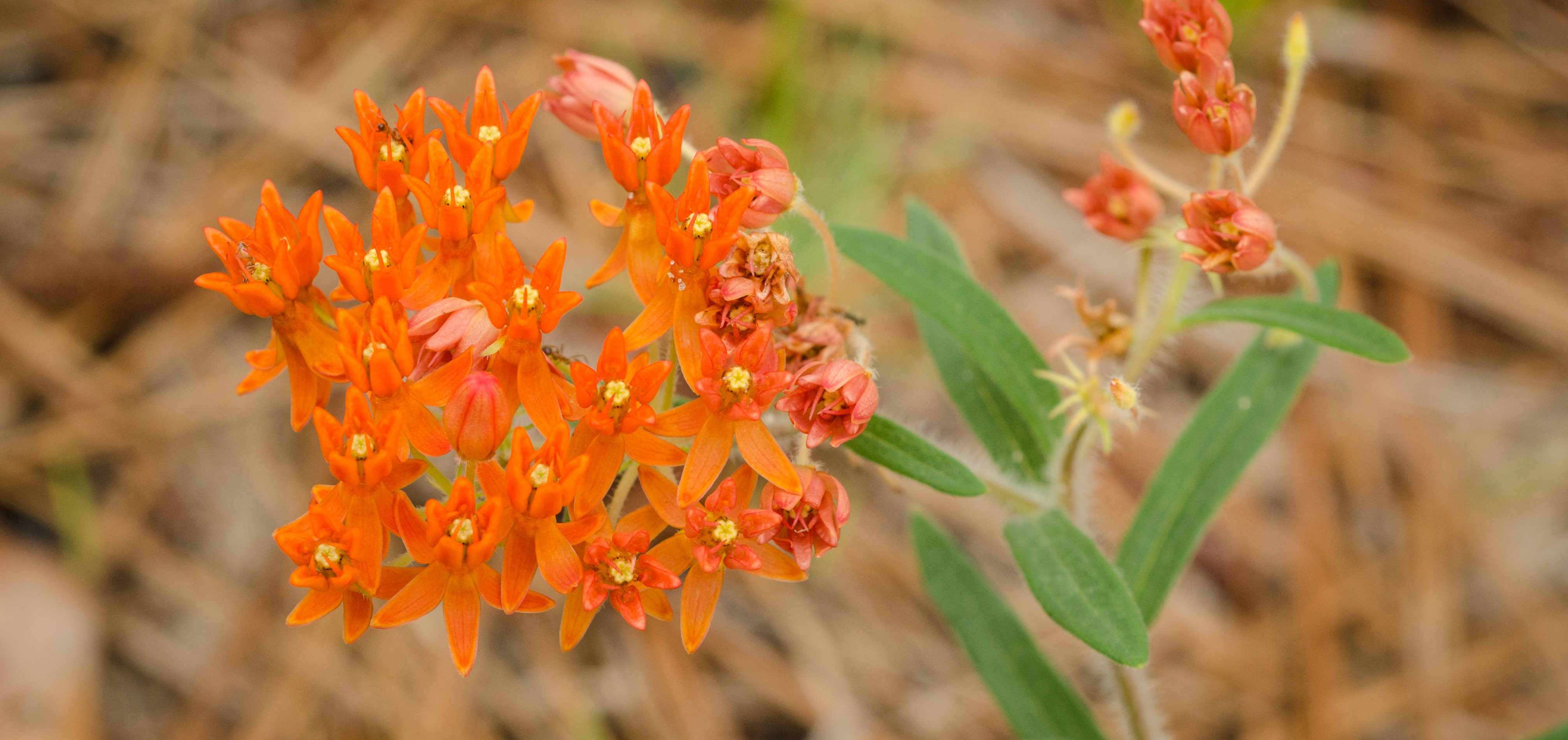Groundcover Restoration
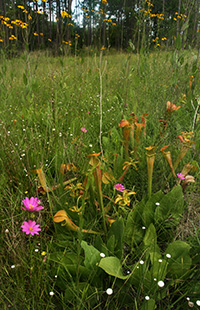 Hillside Seepage BogPhoto Credit: Matt Buckingham
Hillside Seepage BogPhoto Credit: Matt BuckinghamGroundcover restoration is a key component of the longleaf forest. What are the benefits of including groundcover as an important attribute of your forest?
What’s the Difference Between Groundcover and Understory Restoration?
Definition and use of these terms varies. Some consider understory as shrubs, grasses, and forbs. Others use the term understory to mean grasses and forbs and the soil surface. Another term used is herbaceous groundcover or herbaceous understory. To be consistent with our many partners including the Longleaf Partnership Council, the Texas Longleaf Taskforce uses the term groundcover to include grasses, sedges, rushes, forbs and wildflowers found on the forest floor.
Benefits of Groundcover
There are many benefits attributed to the establishment and enhancement of groundcover. Some are listed below:
- Wildlife Diversity and Health - Wildlife species depend on plant communities for feeding, nesting and shelter. See more discussion in the Wildlife Section of this webpage.
- Plant Diversity - The longleaf forest is known as one of the most diverse habitats in North America. A wide diversity of species has evolved with this forest type.
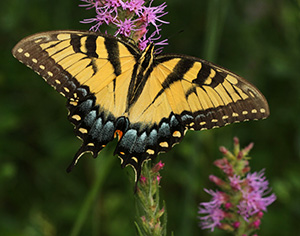 Eastern Tiger Swallowtail Butterfly on GayfeatherPhoto Credit: Matt Buckingham
Eastern Tiger Swallowtail Butterfly on GayfeatherPhoto Credit: Matt Buckingham -
Rare, Threatened, and Endangered Species - Loss of habitat, or poor habitat conditions often contribute to the decline of flora and fauna. By improving habitat, you will contribute to improving conditions for these species. In Texas, the population of the endangered red-cockaded woodpecker (RCW) has been growing as a result of creating open forest stands with a diverse groundcover which leads to an increase number of insects, a mainstay of the RCW diet.
- Native Pollinators - In recent years there has been a great deal of attention and management to encourage the establishment of plant species to benefit native bees and butterflies. Not only are these pollinators vital for the function of forested systems, but they also are critical to our nation’s agricultural production.
- Forest Management - With a historic regime of natural lightning fires occurring in the longleaf communities, these systems were dominated by grass, forbs and wildflowers. Today we rely on the use of controlled, or prescribed fire to mimic this historic process. Grasses are the necessary fine fuel source for ignition of fire in the longleaf forest. Following fire activity, wildlife take advantage of the highly nutritional fresh growth of plants for forage and browsing.
- Agro Forestry - Historically in some parts of the range, longleaf forests have been used for livestock grazing. As with wildlife, cattle benefit from nutritional growth of grasses and forbs following the application of fire. Today there is renewed interest in using woodlands cattle for rotational grazing in longleaf stands. There is more to be learned on how grazers affect site soil health, interact with pollinators, and management with fire and hardwood shrub management.
- Aesthetics - Often hard to quantify and monetize, there is great value and appreciation for the aesthetics of a forest that has a diversity of plant and animal life and open vistas for the eye. For some landowners this is one of their most passionate interests.
What Plants Are Found in Groundcover?
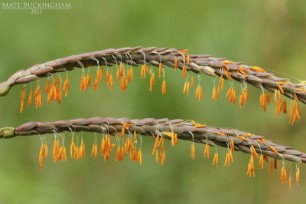 Eastern Gama GrassPhoto Credit: Matt Buckingham
Eastern Gama GrassPhoto Credit: Matt BuckinghamGroundcover in the longleaf pine Coastal Plains of the southern states is very diverse and separated into two general types. From the central part of south Alabama and northwest Florida heading west into Texas, bluestem (Andropogon spp.) and panicum (Panicum spp.) grasses predominate the forest floor. To the east, wiregrass (Aristida stricta) is most common. Many of these species are perennial bunch grasses which have an extensive underground root system allowing them to persist through surface fires.
GRASSES
- Bluestems - There are many types of bluestems. Little Bluestem (Schizachyrium scoparium), Big Bluestem (Andropogon gerardi), Bushy Bluestem (Andropogon glomeratus) , Slender Bluestem (Schizachyrium tenerum) are the most common. In east Texas Pinehill Bluestem (Schizachyrium scoparium var. divergens) is the focus of production plots for restoration of much of the potential upland longleaf pine forest habitat. On disturbed or overgrazed sites Broomsedge (Andropogon virginicus) is common.
- Panicums - There are many types of Panicums with Switch Grass (Panicum virgatum) being the most common.
- Paspalums (Paspalum spp.)
- Indian Grass (Sorghastrum nutans)
- Eastern Gama Grass (Tripsacum dactyloides)
- PineyWoods Dropseed (Sporobolus junceus)
- Purple Lovegrass (Eragrostis spectabilis) - This is a favorite for some with its purple showy inflorescence (flower head) in the fall months.
- Arrowfeather Three Awn (Aristida purpurascens)
- Toothache Grass (Ctenium aromaticum)
- Giant Cane (Arundinaria gigantea) - This is the only native bamboo that grows west of the Mississippi River in association with longleaf. Typically found in wet bottomland hardwood areas, it can be found scattered in some upland sites. Native bamboo can often be overlooked since non-native cane (Arundinaria) has invaded much of the southern riparian systems.
OTHER GRASS-LIKE PLANTS
Sedges (Cyperaceae Family) and rushes (Juncaceae Family) make up a large percentage of the groundcover, especially in the wet longleaf pine savanna.
Basic features can be used to distinguish the two families, and some can be identified in the field on site, but often closer examination of fruits, flowers, or plant structure, including under magnification is needed.
FORBS - Legumes
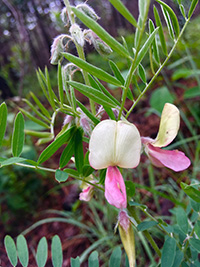 Goat's RuePhoto Credit: Kristin Leger
Goat's RuePhoto Credit: Kristin LegerVarious species of beans, clovers, peas and vetches are known as legumes. Legumes are highly desirable for groundcover -providing nutritious seeds for a variety of wildlife including Northern Bobwhite, Eastern Turkey, and songbirds. Legumes provide additional benefit by enhancing soil health- they are referred to as nitrogen-fixing plants. Growing in a mutually beneficial relationship, soil-dwelling bacteria receive nitrogen from the air, the bacteria provide nitrogen to the legumes and the plants, provide carbohydrates to the bacteria.
- Goat’s Rue (Tephrosia virginiana)
- Lespedeza (Lespedeza spp.)
- Pencil Flower (Stylosanthes biflora)
- Sensitive Brier (Mimosa)
- Snoutbean (Rhynchosia spp.)
- Tickclover (Desmodium spp.)
- Wild Indigo (Baptisia spp.)
FORBS - Composites
Plants that are composites are members of the large Sunflower family. They are often showy and summer/fall bloomers and are prolific seeders.
- Fleabane (Erigeron)
- Goldenrod (Solidago spp.)
- Liatris or Blazing Star (Liatris spp.)
- Purple Coneflower (Echinacea spp.)
- Sneezeweed (Helenium)
- Sunflower (Helianthus)
- Tickseed (Coreopsis)
Seed Banking
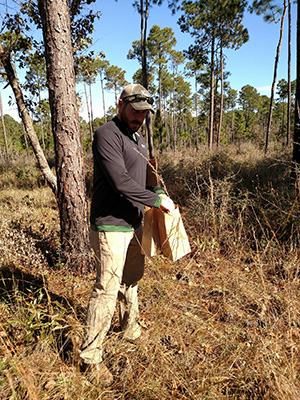 Native seed collection at the Roy E. Larsen Sandyland SanctuaryPhoto Credit: Wendy J. Ledbetter
Native seed collection at the Roy E. Larsen Sandyland SanctuaryPhoto Credit: Wendy J. LedbetterIs there a seed bank of desirable groundcover species in the ground? It depends on a lot of factors such as land use history, soil disturbance, past management practices, and the presence of non-native/invasive species. Some species have seed that remains viable in the soil for years, and species vary with seed source.
Land management treatments such as prescribed fire, disking, reducing dense hardwood shrubs, and treating invasive plants may allow sunlight to the forest floor and or stimulate seed germination. Conducting management treatments and waiting to see how the vegetation responds may be in order. Check with your local sources for assistance in identifying what plants are on your site.
Bud Banks
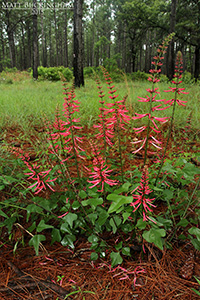 Longleaf pine upland forest groundcover (Coral bean in the foreground)Photo Credit: Matt Buckingham
Longleaf pine upland forest groundcover (Coral bean in the foreground)Photo Credit: Matt BuckinghamSome plants do not have long-term seed in the ground, but can remain as a dormant bud for many years. These long-term perennial plants will tend to stay dormant until right conditions occur in the forest, at which time they will sprout from the “bud” base of the plant. For example: wiregrass will remain dormant under a thick mid-story vegetation, but will sprout and grow after the mid-story is removed and sunlight light reaches the forest floor.
For more information on bud bank basics visit Texas A&M Agrilife Extension's Bud Bank Basics.
Management Options
There are many choices for your land resources, including retaining native, perennial herbaceous groundcover. All choices/actions will be driven by your ultimate goals/objectives for your property. Take advantage of your local agency/organization/forestry consultants/vendors/other landowners to provide on the ground experience and recommendations for selecting the type, scope and order of treatments for your desired vision for your property.
- Tree survival and growth can occur in conjunction with maintaining a grass-dominated understory with a diverse array of forbs and wildflowers.
- The application of fire using prescribed burning continues to be used as an alternative for economical land treatment and benefits several of the fire-adapted species of the pine forest community. Fire alone, or in combination with chemical application can be used for controlling undesired shrub vegetation.
- Limiting intense mechanical disturbance in the form of deep, soil movement, and erosion may avoid losing some of the plant’s root systems.
- Expect that with elimination of the tree canopy, sites will respond to the sunlight with non-native/invasive species such as Chinese tallow, weedy annual plants or a vigorous re-sprout of remaining hardwood shrubs (sweetgum, oaks, yaupon holly, and wax myrtle). Ensure that you have fire/chemical or a combination of these treatments to respond to vegetation growth.
Consider what are the target species for control or elimination from a site. Select broadcast or targeted chemical applications with care. Note some legumes can persist with multiple applications of herbicide.
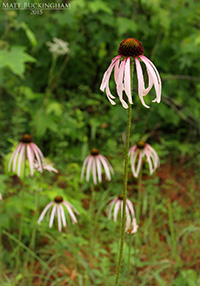 Sanguine's Purple ConeflowerPhoto Credit: Matt Buckingham
Sanguine's Purple ConeflowerPhoto Credit: Matt BuckinghamNative Seed/Plant Availability and Purchasing
Native seed is available for purchase through growers who collect native seed by hand or machines from wild locations and/or have their own established production areas. Agencies and organizations interested in promoting native wildlife and plants may have seed/plants available. Great care and effort are taken by native seed/plant vendors to ensure purity of product and the best options for your area. Purchasing of quality, viable seed and controlling competitive vegetation improves the chance for successful establishment of desired species. Seed is usually sold by the pound. Vendors can assist you with determining the right species to use and calculating the amount of seed you will need for a planting area.
Does It Matter Where Seed Comes From?
Although we don’t know all the answers yet, conserving local genetics of plant populations is considered valuable for adaptation to site soils, climate and environmental conditions. Just as with tree planting, using seed from east Texas/western Louisiana versus other areas of the southern landscape is favored. It is recommended that you communicate with your local technical assistance teams, resource professionals and native plants experts in your region for recommendations.
Timing of Sowing/Planting
Typically, cool weather and moist soil conditions are optimum for planting. This usually occurs in the fall months before the first frost. Ample moisture and soil conditions are key for sowing and planting success. It is recommended you consult with local resource professionals, nurseries, growers, consultants, and county extension agents to optimize planting for your location.
About Pollinators
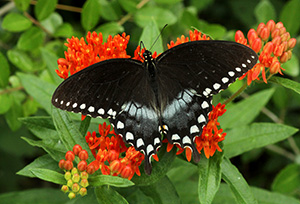 Spicebush Swallowtail Butterfly on ButterflyweedPhoto Credit: Matt Buckingham
Spicebush Swallowtail Butterfly on ButterflyweedPhoto Credit: Matt BuckinghamAbout 75% of the world’s fruit and vegetable production and other plants as well depend on pollinators for reproduction. Insect pollinators include bees (honey bees, and bumblebees), wasps, ants, beetles, moths and of course the most popular - butterflies. Birds and bats can also serve in this role.
In search of food or nectar, pollinators visit plants and in turn deposit pollen. Plants serve three important functions for pollinators such as butterflies: 1) they provide a substrate for laying eggs, 2) they provide food for larvae and caterpillars to feed, and 3) they provide food in the form of nectar.
Currently a lot of attention is being focused on pollinators since habitat loss, disease, and environmental contaminants have been identified as factors contributing to their decline.
Promotion of native plants, whether in forested systems or rural, suburban or urban settings is a great way to allow continued success for these essential creatures.
Food For Thought….
- Consider giving the land time to respond to management treatments to allow what existing species are there time to respond.
- There are many species we do not have all the information on for how to reproduce. Continue to stay informed of new information and knowledge.
- Expect that weather or other events can be challenging.
- Additional or repeat seeding or planting may be necessary.
- A vision and plan for what you want to achieve on the landscape requires commitment and patience for success.
- Restoration is an art and a science and takes time!
To learn more about the groundcover plant species in East Texas, visit out Groundcover Plants of Longleaf Forests in East Texas page!
